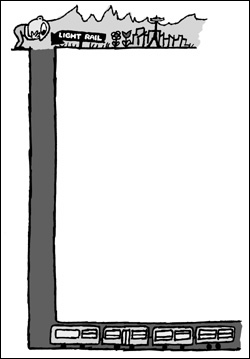At its meeting April 22, the friendly and ultracompetent new regime running Sound Transit reached consensus, sort of, on a light-rail route north from downtown—some of it, anyway. The rest of the route is to be worked out behind closed doors between now and the May 20 board meeting. The announcement was a rare glimpse behind the We’ve Really Got Our Act Together Now facade of Sound Transit’s troubled light-rail project. The reality is that there’s still plenty for the public to be concerned about.
The first concern, as always, is process. The April meeting solidified the rail line’s route north from downtown to the University District, including stops on First Hill and Capitol Hill (on Broadway near Seattle Central Community College) and at Husky Stadium, and at Northeast 45th Street and Brooklyn Avenue Northeast. The process leading to the selection of those four stops—at least two of which have not been precisely sited—has been enough to alienate community groups, especially on Capitol Hill, who don’t feel Executive Director Joni Earl and her staff are taking their concerns into account.
But beyond Seattle’s usual process squabbles, Sound Transit is threatening to land its light-rail project in trouble, again, over the same problems that so alienated the public in its early years: money and relevance.
Based on these four stops, it’s hard to imagine nearly enough people riding light rail to justify the project’s enormous construction hassles and costs. No rising above it all and scenic views here—the trains will tunnel, deeply, not seeing daylight between the Convention Center and somewhere north of the U District. The stations will be deep, too—reachable by elevator for the full aesthetically claustrophobic transit experience.
Taking this train will require some determination. And seeing as how the route mirrors the two most heavily traveled bus routes in the city—the 7 and the 43—few people will be getting out of their cars to take this train. More than likely, they’ll switch from existing public transit, raising the question, all over again, of how effective a use of money this route is. Especially as it won’t serve either north Capitol Hill or the bulk of the University of Washington campus—areas that will be a brisk walk, and an elevator ride, from the nearest train.
Ah, the money. Sound Transit also unveiled its cost estimate for the north extension: $2.5 billion, which sounds like a lot until you consider that the south line is costing a full $2 billion and it’s not tunneling, expensively, deep under Capitol Hill and the Montlake Cut.
Want a better analogy? The current proposal to replace the aging Alaskan Way Viaduct imagines tunneling beneath 1.5 miles of waterfront—a shorter distance than Sound Transit’s proposed north line. The cost of burying the viaduct is estimated at $6 billion.
Factor in the additional costs for three stations in dense neighborhoods, and it’s very easy to imagine that $2.5 billion inexorably rising, doubling, even tripling in coming years, just as the original ballooning cost estimates soured the public on Sound Transit in the late 1990s.
In fact, cost overruns on this line are so easy to imagine that it’s hard to believe Sound Transit is taking its own numbers seriously. They’d better. The public’s current relative absolution of Sound Transit for its past troubles could dissolve all too easily. Just look at the stunning number of additional high-ticket transportation projects that are either already in the works locally, or need to be. The Alaskan Way Viaduct, a new Highway 520 floating bridge, Interstate 405’s expansion, the monorail’s Green Line, and reconstruction of Interstate 5 all through Seattle—each, by itself, is a project that could stretch a region’s finances and cause commuting nightmares during construction. Put five or six of them together, and the public is likely to have little patience for any of the projects playing fast and loose with cost estimates or completion dates. Especially when the agency involved began its life doing exactly that.
As you read this, Sound Transit’s planners and board members are working behind the scenes to reach consensus on both details of the downtown–University District stretch and a plan to extend the line to Northgate. Presumably, the public will be given the final plan at Sound Transit’s May 20 meeting. That meeting will establish a baseline—in siting details, cost estimates, and timeline—against which the public will measure progress for years.
So far, Sound Transit seems to be badly low-balling a major public transit project. With all the transportation projects our region faces, we need honest accounting. The last thing we need is yet another instance of a transit agency playing bait and switch. Sound Transit has a couple of weeks to get it right.







